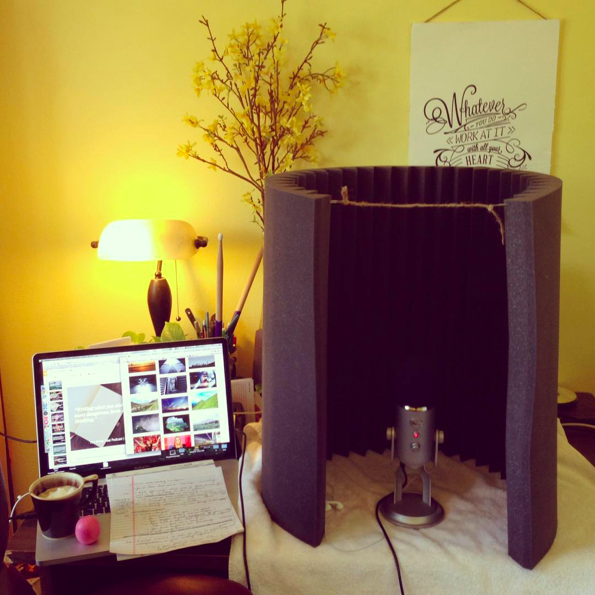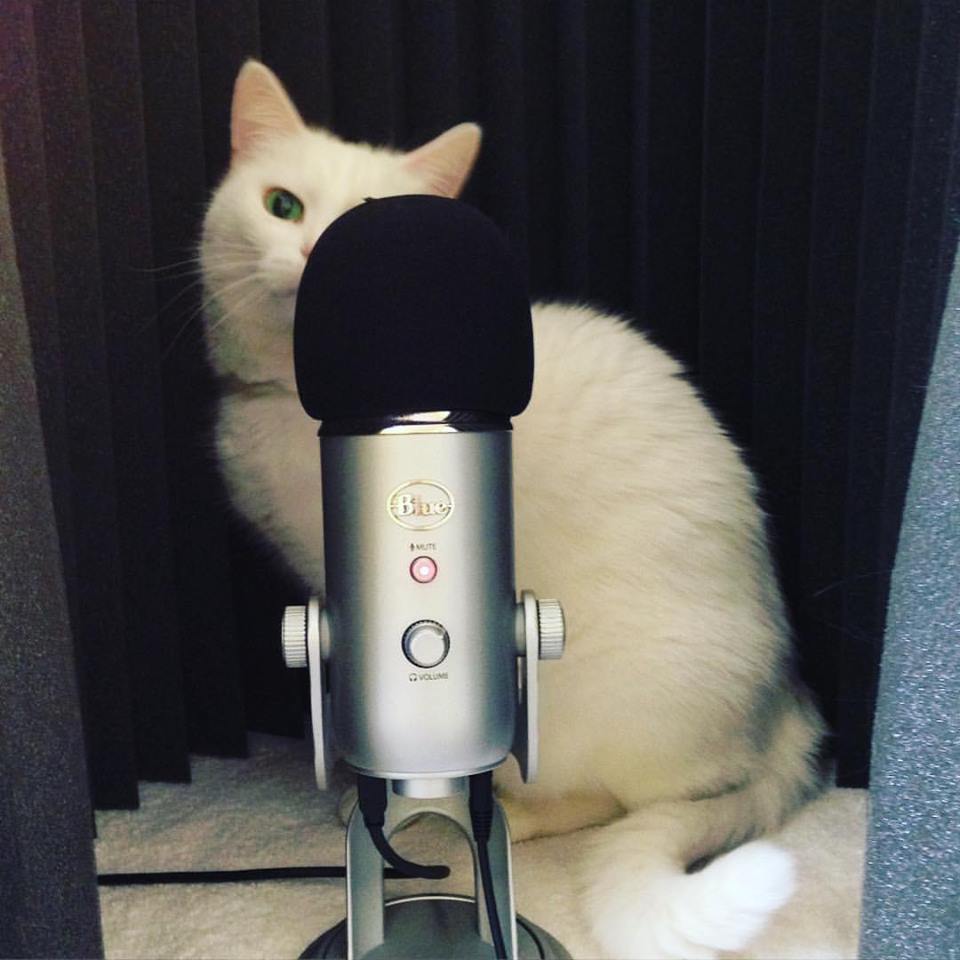How Do You *Not* Sound Like You’re In A Tunnel?
I record absolutely everything — Girl In Space, the Write Now podcast, and all of my lines and roles for other shows — with my basic Blue Yeti USB microphone. And one of the questions I’m asked most frequently is, “Sarah, how do you not sound like you’re recording beneath a highway overpass?”
I firmly believe that you do not need to spend hundreds or thousands of dollars on recording equipment. You can create an amazing, professional-quality show with relatively inexpensive equipment like the Blue Yeti as long as you understand how to record with it.
Get Rid Of The Echo
Hard surfaces and sharp angles are the worst of the recording culprits. Get rid of them with curves and soft, absorbent surfaces.
I have a large piece of audio foam that I’ve removed ALL angles from by forming it into a semicircle. I also have a foam windscreen atop the mic itself (the little foam hat), as well as a cheap folded towel on my desk to further absorb sound/echoes.
You may also want to have something behind you as well — a hanging duvet, moving blanket, bunch of t-shirts on hangers, whatever you have access to. I don’t have this, because my body blocks and absorbs all sound coming in and out of what I’ve dubbed my TUBE OF PODCASTING.
Sometimes my cat, Midori, joins me… and while she makes an excellent sound dampener, the purring, sound of constant movement, and coating of cat hair really cancel out any benefits.
Here’s a real-life picture of my setup:

Get Close To The Mic… No, Closer!
Most people record way too far away from their microphone.
Ideally, your mouth should be about a fist’s space away from the mic when you speak into it, and the gain on the mic (the dial on the back, if you’re using a Blue Yeti) or your recording software should be adjusted so that when you speak at that distance, the sound registers around -12dB.
And if you’re using a Blue Yeti, you should be talking into the front of the microphone, not the top.
Monitor Yourself
Be sure to wear headphones while you record to get a good feel for how you sound. If you’re following the above two tips, your voice should sound up-close and velvety to your ears.
Questions?
I love to help both new and established podcasters find success in podcasting. Type your questions in the comments below and I’ll do the best I can to help you out!
Looking to start your own podcast?
Looking to start — or improve — your podcast in a couple simple steps? I'd love to share my FREE Printable Podcast Roadmap with you! 🎙️✨
This roadmap is the perfect starting point for new podcasters, and a great checklist for podcasting veterans! Now is the PERFECT time to re-evaluate and re-assess what success means for your show, and this handy tool will help you do just that.


What if you are singing opera? I want to use it for ZOOM voice lessons
Gosh, hmmm. I don’t think I’m 100% qualified to comment since I haven’t done any singing with my mic, but I have done a lot of shouting with voice acting. When I do, I have to turn the gain WAY down and back far away from the microphone to prevent peaking and clipping. I wonder if you might be better served with a less-sensitive microphone. -Sarah
OMG, who would of thought simply not tilting the microphone and moving a bit closer, not a lot just a tad, would make my audio sound, well like you put it, velvety. These two simple tips have actually re-inspired my love for video creation in regard to audio. Sarah thank you sooo much, you’re a legend.
Cheers from Australia.
Cheers, Logan — I’m so glad!!! 🙂 -Sarah
I have a problem with being close to the mic. I am a radio interviewer for forty years, and my process involves looking at my notes. This is, of course, an issue when I’m in front of an audience, but not in the studio. I not only look at my notes, but I jot things down as well. But I’ll work harder at it.
Hi Richard, that sounds frustrating. Is there a way to reconfigure your setup so that you can do everything you need to? — Sarah
Hi, Sarah, am appreciating these tips because I use a Blue Yeti also. But am getting a little bit of echo, even though I’m surrounded by hanging beach towels. I like the audio foam semicircle in your photo. In your setup, where would you place a script, like a book you were recording? Thanks!
Hi Priscilla, thank you for your kind words! You might need to get closer to the mic — your mouth should be about a fist away from it. I usually prop my scripts up on the audio foam behind the mic, or tape them there. That way I can get close to the mic and reduce echo while reading my scripts! I hope this helps! <3 — Sarah
What do I set gain to to record at around 3-4 feet away? Or is that not possible?
It is! Just experiment until you see your voice coming in at -12 db. 🙂
Hi Sarah,
Your tube of podcasting doesn’t look like you have any room to read a script or place one in front of you. How do you work around it?
Hi JQ! I either prop up my phone against the back of the foam if I’m reading digital scripts, or I prop up the written/printed pages there! 🙂 Hope this helps, and happy podcasting! -Sarah
Wow. This article is really helpful when it comes to setting up the microphone. Thanks Sarah. Nicole from Jamaica.
Thank you, Nicole! I’m so glad it helped! -Sarah
Hi Sarah, I have just recently discovered your refreshingly informative and enjoyable Write Now podcasts. I’m listening to them daily and absorbing all the tips and affirmations that apply to my situation.
I’d like to know how you record your guest speakers for Coffee Break episodes. I assume you talk to them over the phone while recording.
Many thanks –
Susan
Hi Susan! I’m so glad you’re enjoying my show! I record some of my Coffee Break episodes in person, but most are done over Skype using the Ecamm Call Recorder. I hope this helps! -Sarah
Thank you so much, Sarah. Sorry for delayed response, but I didn’t see your response until today. I expected some type of “notification” that I received a response. Maybe I just missed it. Either way, thank you for sharing. I interview veterans from WWII to present to preserve their stories for future generations at the Library of Congress. I am an anthropologist professionally and in heart and soul, so writing and researching has been the foundation for everything I do. Life made some difficult unexpected curves for me in 2006, but I have steadily steered forward to enjoy new adventures and purposeful experiences. Your probably 1/2 my age, but still I find a special connection with your perspective and outlook on life. Thank you!
Thanks for the tips. Could you post a photo of the towel and the foam windscreen you mentioned? Reason I ask- in my case I’m speaking live to viewers of a webinar. So I want the towel or any sound absorption completely out of view. So what does your setup look like?
Hi Mike, that’s a great question! I just added a picture of my podcast-recording setup to the blog post above. 🙂 As for the webinar setup, if you have everything INSIDE the foam, or if the foam is a little more distanced, viewers shouldn’t be able to see it. I did the same thing for a series of webinars I did. I hope this helps!
Hi and Thanks. Can I cover the mic with cotton fabric to reduce echo?
Hmm, you could give it a try… as long as the cloth is secure and doesn’t move against the microphone it might work… let me know!